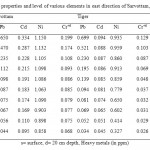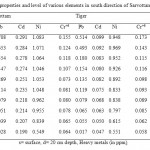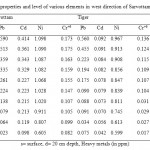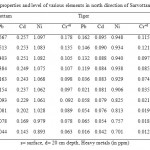Effect of Heavy Metal Present in Cement Dust on Soil and Plants of Nokha (Bikaner)
Suruchi Gupta1 and Sarika Sharma1
1
Research Laboratory,
Government Dungar College Bikaner,
India
DOI: http://dx.doi.org/10.12944/CWE.8.2.16
Copy the following to cite this article:
Gupta S, Sharma S. Effect of Heavy Metal Present in Cement Dust on Soil and Plants of Nokha (Bikaner). Curr World Environ 2013;8(2) DOI:http://dx.doi.org/10.12944/CWE.8.2.16
Copy the following to cite this URL:
Gupta S, Sharma S. Effect of Heavy Metal Present in Cement Dust on Soil and Plants of Nokha (Bikaner). Curr World Environ 2013;8(2). Available from: http://www.cwejournal.org/?p=4783
Download article (pdf) Citation Manager Publish History
Select type of program for download
| Endnote EndNote format (Mac & Win) | |
| Reference Manager Ris format (Win only) | |
| Procite Ris format (Win only) | |
| Medlars Format | |
| RefWorks Format RefWorks format (Mac & Win) | |
| BibTex Format BibTex format (Mac & Win) |
Article Publishing History
| Received: | 2013-06-20 |
|---|---|
| Accepted: | 2013-08-25 |
Introduction
Complex electronic chemistry of heavy metals viz.Cr+6, Pb, Cd and Ni have been a major hurdle in unraveling its toxicity mechanism in soil and plants.1 Heavy metal toxicity in plants is observed at multiple levels from reduced yield, through effects on leaf and root growth, to inhibition an enzymatic activities and mutagenesis. The area under present investigation is a large industrial area with two cement plants running for a very long time along the roadside on NH 89.
Experimental
Study Area
Nokha is located within the arid western desert region of Rajasthan at a distance of 63 km from the city of Bikaner. Its temperature varies from 48 degree in summer to 1 degree in winter with annual rainfall of about 298 mm. To study the effect of cement dust, whole area around three cement plants namely; Sarvottam, Tiger cement and Nokha cement were studied. the Sarvottam cement plant which is located at the distance of 5 km from Nokha (Bikaner) on national highway number 89 near Charkhada village; Tiger and Nokha cement are located in RIICO industrial, Nokha area at a distance of 500m from each other.
Sampling and Procedure
Study area around the plants was divided into four radiant directions of east, south, west and north in clockwise manner.2,3 Soil samples were taken at surface and 20 cm depth at 100m, 500m,1 km,2km and 3 km distances(10 samples each) in plastic bags of ½ kg each. Prior to analysis, the samples were cleaned using wire mesh and pebbles removed. The samples were filtered using Whatman no.42 filter paper. Cr+6, Pb, Cd and Ni was determined by atomic absorption spectrophotometer (nov AA 400) in flame mode as given by Perkin Elmer.4
Results and Discussion
The present study was carried out to study effect of heavy metal present in cement dust on soil and plant during 2009-2010. As per central pollution control board standards of (1995), chromium(0.1 ppm),Pb(0.1 ppm),Cd(2 ppm) and Ni(3 ppm) is toxic for agricultural operations and industry.5 A perusal of table 1,2,3 and 4 revealed following results.
East Direction
Sarvottam Cement
Lead content ranged between 0.650 to 0.112 ppm upto 500m distance all of them above limit after that it declined below limit. Hexavalent chromium, cadmium and nickel content was lower at all the distances.
Tiger Cement
Lead content ranged higher between 0.699 to 0.139 ppm upto 1km. Hexavalent chromium also ranged higher between 0.199 ppm to 0.108 ppm upto 500m. However, cadmium and nickel content was relatively much less compared to other two plants.
Nokha Cement
Lead content ranged higher between 0.515 to 0.118 ppm upto 500m distance only. Hexavalent chromium also was higher in the first 100m ranged between 0.129 ppm to 0.103 ppm, however at all other sites it was below limits. Interestingly, cadmium and nickel content was lower at all the distances both at surface and 20cm soil depths.
South Direction
Sarvottam Cement
Lead content ranged higher between 0.708 to 0.114 ppm upto 1km distance. Hexavalent chromium, cadmium and nickel content was lower at all the distances.
Tiger Cement
Lead content ranged between 0.511 to 0.119 ppm all of them were above limit upto 1 km distance more so on surface soil than at 20cm depth. Hexavalent chromium ranged between 0.155 to 0.118ppm upto 500m distance, however, showed decline after that. Cadmium and nickel content was lower at all the distances. Nokha Cement Lead content ranged higher between 0.441 to 0.203 ppm upto 2km more so on surface soil than at 20cm depth. Higher hexavalent chromium ranged between 0.173 to 0.116 ppm upto 500 m distance, however, showed decline after that. Cadmium and nickel content was lower at all the distances.
West Direction
Sarvottam Cement Lead content ranged higher between 0.590 to 0.138 ppm upto 2km. Hexavalent chromium, cadmium and nickel content were lower at all the distances. Tiger Cement Lead content was higher ranged between 0.560 to 0.175 ppm upto 1 km distance. Hexavalent chromium ranged between 0.173 -0.105 ppm higher above limits upto 2 km distance. Cadmium and nickel content were lower than prescribed limits.
Nokha Cement
Lead content ranged between 0.427 to 0.137 ppm all of than above limit upto 2 km distance. Hexavalent chromium ranged between 0.136 -0.104 ppm higher above limits upto 1 km distance surface soil. Cadmium and nickel content were lower than prescribed limits at all sites.
West Direction
Sarvottam Cement
Lead content ranged higher between 0.590 to 0.138 ppm upto 2km. Hexavalent chromium, cadmium and nickel content were lower at all the distances.
Tiger Cement
Lead content was higher ranged between 0.560 to 0.175 ppm upto 1 km distance. Hexavalent chromium ranged between 0.173 -0.105 ppm higher above limits upto 2 km distance. Cadmium and nickel content were lower than prescribed limits.
Nokha Cement
Lead content ranged between 0.427 to 0.137 ppm all of than above limit upto 2 km distance. Hexavalent chromium ranged between 0.136 - 0.104 ppm higher above limits upto 1 km distance surface soil. Cadmium and nickel content were lower than prescribed limits at all sites.
North Direction
Sarvottam Cement
Lead content ranged higher between 0.567 to 0.154 ppm all of them above limit upto 1 km. Hexavalent chromium, cadmium and nickel content was lower at all the distances
Tiger Cement
Lead content was above limits ranged between 0.178 to 0.107 ppm upto 500m. Hexavalent chromium ranged between 0.162-0.119 generally higher upto 500m. Cadmium and nickel content was lower at all the distances
Nokha Cement
Lead ranged between 0.267-0.123 ppm generally higher upto 500m distance after that it gradually declined. Hexavalent chromium was higher in the first 100m distance ranged between 0.115-0.121 ppm, however, at rest of the sites it was below limits. Cadmium and nickel content was lower at all the distances
 |
Table 1: Physico-chemical properties and level of various elements in east direction of Sarvottam, Tiger and Nokha Cement Click here to View table |
 |
Table 2: Physico-chemical properties and level of various elements in south direction of Sarvottam, Tiger and Nokha Cement Click here to View table |
 |
Table 3: Physico-chemical properties and level of various elements in west direction of Sarvottam, Tiger and Nokha Cement Click here to View table |
 |
Table 4: Physico-chemical properties and level of various elements in north direction of Sarvottam, Tiger and Nokha Cement Click here to View table |
Conclusion
This is clear from the above study that in case of Sarvottam cement works only lead content was higher in all directions and depth than other two plants. At tiger and Nokha cement works contamination of lead was more over limited in the first 1 km except in east direction. Mobility of lead was relatively more on top soil than 20cm depth. Hexavalent chromium content in south western direction was more for both Tiger and Nokha cement. This indicated influence of prevailing direction of wind on distribution of heavy metals present in cement dust.6 It is concluded from the present investigation that if cement dust with traces of heavy metals continues to fall on soil and plants, it will affect the yield of plants and reduction in fertility of soil. Higher concentration of heavy metals leads to stunted growth, leaf necrosis, decrease in root growth and reduced activities of various enzymes leading to less flowering and seed setting in plants effected. The accumulation of heavy metals in Prosopis cineraria, pearlmillet and clusterbean plant parts which when used by humans will also brings diseases in them viz. changes in gastro intestinal tract as well as in accumulation in liver, kidneys, thyroid gland and bone marrow. The various hexavalent chromium compounds represent the major risk especially due to genetic effect. Keeping above analysis in mind, it is strongly recommended to emit cement dust after treatment with electrostatic precipitator.
References
- Shanker, A. K. and Carlos Cervantes. Environ int., 31: 739(2005)
- Gupta, S. and Solanki, A. Int. J. Chem. Sci. 6(2): 681- 687(2008).
- Ibanga, I.J., Umoh, N.B. and Iren, O.B. Soil analysis and plant analysis. Vol.39(3&4): 552 (2008).
- Isaac, R.A. and Kerber, J.D. Soil science society of America, Madison W.I. (1971)
- Gupta, P. K. Methods in environmental analysis: water, soil and air. Agrobios (India), Jodhpur, p 18-19 (2000).
- Zerrouqui, Z., Sbaa, M., Qujidi, M., Elkharmouz, M., Bengamra, S. and Zerrouqi, A. Assessment of cement’s dust impact on the soil using principal component analysis and GIS. Int. J. Environ. Sci. Tech., 5(1):125-134. ISSN: 1735-1472. (Winter,2008)







